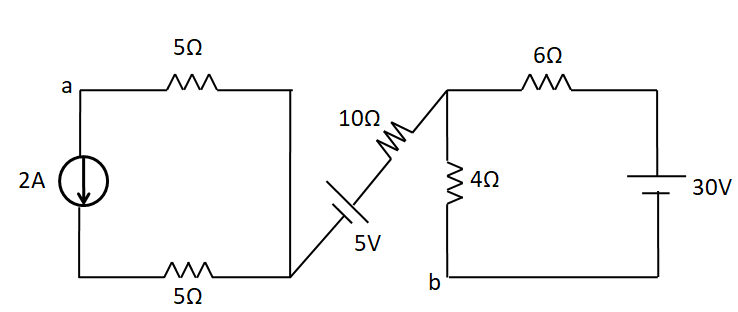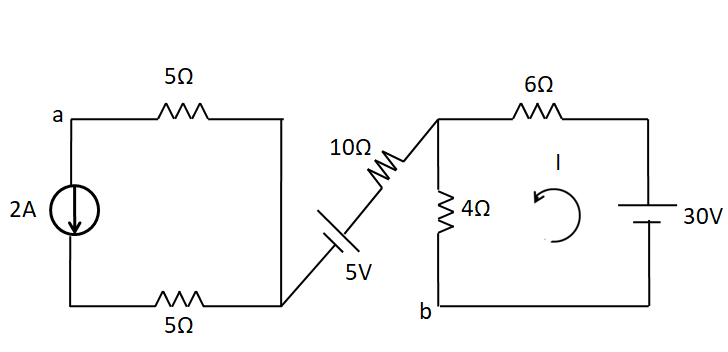
Find the voltage ${V_{ab}}$ in the circuit shown in the figure.

(A) $ + 3{\text{V}}$
(B) $ - 3{\text{V}}$
(C) $ + 6{\text{V}}$
(D) ${\text{ - 6V}}$

Answer
554.7k+ views
Hint
To solve this question, start from the initial potential point and reach to the final potential point through any path. While travelling through a path, write all the potential drops and gains which come in between the path.
Complete step by step answer
As in the first mesh, the current source of $2{\text{A}}$ is present, so the current in the whole mesh is $2{\text{A}}$. Now, we need to find the current in the second mesh using KVL.
We assume a current of $I$ in the second mesh, as shown in the below diagram.

Applying KVL in the second mesh, we get
$\Rightarrow - 30 + 6I + 4I = 0$
$\Rightarrow 10I = 30$
Dividing both the sides by $10$, we get
$\Rightarrow I = 3{\text{A}}$
The current in the branch containing the resistance $10\Omega$ is zero, since it does not form any closed path. So, the potential drop across the $10\Omega$ resistance is zero, and hence it can be discarded out. So, the circuit can be redrawn as

Now, for finding ${V_{ab}}$, we start from the point a, and travel along the path acdb to reach the final point b.
$\Rightarrow {V_a} + 5(2) + 5 - 4(3) = {V_b}$
On rearranging the terms, we get
$\Rightarrow {V_a} - {V_b} = - 3{\text{V}}$
Or, ${V_{ab}} = - 3V$
Thus, the voltage ${V_{ab}}$ is equal to $ - 3V$
Hence, the correct answer is option B.
Note
Do not apply KVL along the path, in between where a current source is there. This is because the potential difference across a current source is unknown to us. Do not assume it to be zero. It can only be found out analytically. So, applying KVL along the path containing a current source will not be possible.
To solve this question, start from the initial potential point and reach to the final potential point through any path. While travelling through a path, write all the potential drops and gains which come in between the path.
Complete step by step answer
As in the first mesh, the current source of $2{\text{A}}$ is present, so the current in the whole mesh is $2{\text{A}}$. Now, we need to find the current in the second mesh using KVL.
We assume a current of $I$ in the second mesh, as shown in the below diagram.

Applying KVL in the second mesh, we get
$\Rightarrow - 30 + 6I + 4I = 0$
$\Rightarrow 10I = 30$
Dividing both the sides by $10$, we get
$\Rightarrow I = 3{\text{A}}$
The current in the branch containing the resistance $10\Omega$ is zero, since it does not form any closed path. So, the potential drop across the $10\Omega$ resistance is zero, and hence it can be discarded out. So, the circuit can be redrawn as

Now, for finding ${V_{ab}}$, we start from the point a, and travel along the path acdb to reach the final point b.
$\Rightarrow {V_a} + 5(2) + 5 - 4(3) = {V_b}$
On rearranging the terms, we get
$\Rightarrow {V_a} - {V_b} = - 3{\text{V}}$
Or, ${V_{ab}} = - 3V$
Thus, the voltage ${V_{ab}}$ is equal to $ - 3V$
Hence, the correct answer is option B.
Note
Do not apply KVL along the path, in between where a current source is there. This is because the potential difference across a current source is unknown to us. Do not assume it to be zero. It can only be found out analytically. So, applying KVL along the path containing a current source will not be possible.
Recently Updated Pages
A man running at a speed 5 ms is viewed in the side class 12 physics CBSE

The number of solutions in x in 02pi for which sqrt class 12 maths CBSE

State and explain Hardy Weinbergs Principle class 12 biology CBSE

Write any two methods of preparation of phenol Give class 12 chemistry CBSE

Which of the following statements is wrong a Amnion class 12 biology CBSE

Differentiate between action potential and resting class 12 biology CBSE

Trending doubts
What are the major means of transport Explain each class 12 social science CBSE

Which are the Top 10 Largest Countries of the World?

Draw a labelled sketch of the human eye class 12 physics CBSE

How much time does it take to bleed after eating p class 12 biology CBSE

Explain sex determination in humans with line diag class 12 biology CBSE

Explain sex determination in humans with the help of class 12 biology CBSE




